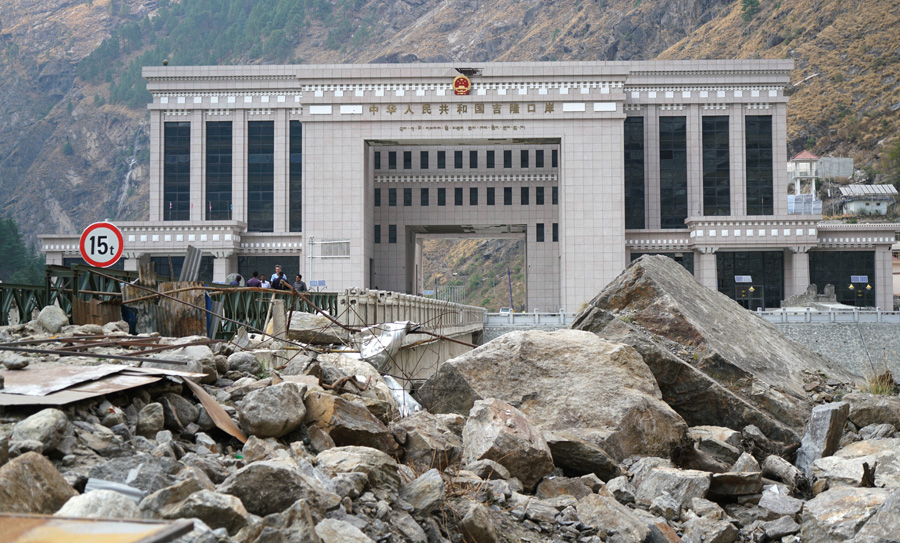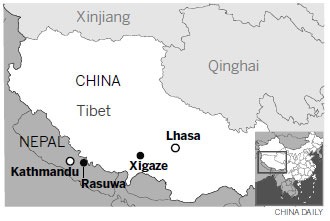 |
|
China's customs and immigration building at the Jilong border. [Photo by Sylvia Chang/China Daily] |
China continues to provide post-quake assistance
By April 20, the China Foundation for Poverty Alleviation, an NGO with links to the State Council, China's Cabinet, had raised 10.62 million yuan ($1.63 million) to assist Nepalese citizens who lost their homes and livelihoods during the magnitude-7.8 earthquake last year.
In the weeks immediately after the disaster, the NGO donated 4.48 million yuan to the emergency rescue services, while a further 1.96 million yuan was used to provide temporary shelters, and 4.17 million yuan was earmarked for reconstruction projects. Nearly 177,500 people will benefit from the donations.
To better carry out reconstruction work, the foundation signed an agreement with the Social Welfare Council of Nepal, and on Aug 13, it set up an office in the capital, Kathmandu, to oversee donations and projects.
On Sunday, a foundation stone was laid at a ceremony in Kathmandu to mark the start of reconstruction work at the Yuba Sahabhagita public school, which was destroyed by the tremblor. The reconstruction efforts will help more than 2,000 students.
Moreover, about 2.7 million yuan will be donated to public schools to help pay for reconstruction of buildings, to provide educational materials and to fund psychological support programs, according to Wang Xingzui, the NGO's vice-president.
For the next two years, the foundation will focus on the fields of education and sanitation to further assist with the reconstruction efforts, Wang said.
Chinese-backed projects face Himalayan task
With thousands of rivers surging through the Himalayas, Nepal has ample natural resources for the generation of hydropower. The country has the potential to produce 43,000 megawatts, but at present only 650 mW can be supplied at peak hours, less than half of the required 1,550 mW, according to statistics from the Nepal Electricity Authority.
China is already an investor in Nepal's hydropower industry, said Sher Singh Bhat, the authority's deputy managing director.
According to the authority's statistics, the first Chinese-invested hydropower project with a generation capacity of 50 mW will begin operations this year. Two Chinese-invested projects with a combined generation capacity of 20 mW are already in operation, and four other projects with a total capacity of about 85 mW are under construction.
For the Nepalese, darkness is an old friend. Even in the capital city of Kathmandu the electricity supply is cut for 12 hours a day. In the dry season, usually October to June, the country faces daily power shutdowns of up to 16 hours.
However, just as it is technically difficult to tap hydropower from the torrents rushing down between the cliffs, engineers and investors face many challenges, ranging from harsh conditions to disruptions by the local community and reams of red tape.
The devastating earthquake that struck Nepal on April 25 last year also damaged a number of hydropower projects under construction.
"We resumed work in September, but progress is very slow," said Li Haiyuan, project manager of the Rasuwagadhi hydroelectric project, which is being built by the China International Water and Electric Corp, a subsidiary of the State-owned China Three Gorges Corp.
The 111-mW project is located 5 kilometers from the Rasuwa border crossing between China and Nepal. Because the project was just 67 km from the epicenter of the quake, it suffered severe damage. Two workers from Li's team lost their lives, and the project suffered a loss of 100 million yuan ($15 mill-ion).
The Upper Tamakoshi Hydroelectric Project is located in Dolakha district, which also sustained severe damage. With the capacity to generate 456 mW, and with construction managed by Sinohydro Corp, a subsidiary of the State-owned Sinohydro Group, it is the largest under-construction project in Nepal.
"The road collapsed, transmission lines were slashed and the dam was flooded. The project has been delayed for at least two years," said Wang Gaobo, general manager of Sinohydro.
Rajesh Kazi Shrestha, president of the Nepal-China Chamber of Commerce and Industry, said it has been hard to attract large-scale Chinese projects to the country, despite the tremendous need for infrastructure investment.
Some of the challenges faced by potential investors include land acquisition and demands from affected communities, he said, adding that political wrangling in Nepal had also deterred many investors.
Complicated formalities and rules were among the other causes of uncertainty for many big projects.
Li, from China International Water and Electric, said the company's first investment in Nepal, the 25 mW Upper Madi Hydroelectric Project, was made "to test the waters", but the prolonged construction period resulted in the company making additional investment in the project.
Santa Gaha Magar contributed to this story.
